Barberry Golden Ruby: all about growing a bush
Barberry Golden Ruby belongs to the Thunberg barberry species, genus Barberry. It is a dwarf shrub with brightly colored leaves. Their color depends on the time of year and the amount of sunlight that falls on the leaves.
Content:
- Description of barberry
- Barberry Golden Ruby
- Reproduction of barberry Golden Ruby
- Growing barberry Golden Ruby
- Barberry care
- Diseases and pests
- Winter preparation and use
Description of barberry
The fact that in modern classification barberries the species, genus, popliteal, subfamily and family of Barberry are present, indicating a significant number of them in nature. Wild barberry is a shrub with spiny, ribbed shoots of yellow or red color. In most species, at first they are straight, gray or brown over the years, bend to the ground.
The juice that stands out at the cut is colored bright yellow.
It has long been used for dyeing fabrics and other materials. There are evergreen and deciduous species of barberry. Evergreens grow in southern latitudes, deciduous ones - in northern ones. Some species grow in the mountains. The leaves are rounded, often bordered with soft or thorny teeth. Color - from green to gray, the whole gamut of yellow-red, purple tones. The spines are single or tripartite, very sharp, about 1 cm long.
Barberry flowers are yellow, collected in inflorescences. Bloom in May. In place of flowers, small oblong or semicircular fruits appear, which turn red or dark blue by autumn, depending on the species. Their length ranges from 3 to 5 mm. The fruits are distinguished by a special taste with a pleasant, rather strong acidity. The shrub is considered decorative, although many types of fruits are widely used raw or dried as an addition to various dishes. An oblong bone is located inside. If the fruits are not plucked, they can sag on the bush until spring, slightly discoloring from frost. The bush quickly grows in breadth due to lateral growth.
There are about 100 types of barberry. Among them, the Thunberg barberry, named after the Swedish scientist who was involved in the description and systematization of plants, stands out for its decorative effect. Its natural habitat is the Far East. But it has long taken root in Europe and North America.
Barberry Golden Ruby
Golden Ruby belongs to the Thunberg barberry species. This is a dwarf variety. The bush is low, from 35 to 50 cm, with a rounded crown with a diameter of about 60 cm.
Its main decoration is small rounded leaves that constantly change their color.
In spring they are apricot, then darken, acquiring a coral-red hue. By August, a yellow border appears on them. In autumn, the color of the leaves turns bright yellow. The bush blooms in May with clusters of small yellow flowers usual for barberry.
But the fruits are rarely formed. Resistant to frost, so adult bushes do not require shelter for the winter. Grows well on loose, moisture-permeable soils. Does not tolerate stagnant water near the roots.
Reproduction of barberry Golden Ruby
Barberry usually reproduces well. seeds... They are stratified in wet sand for several months at a temperature of about 6 ° C. But barberry Rudy Gold rarely forms seeds, so this method is often unavailable.
Golden Ruby barberry is propagated dividing the bush or green cuttings.
The bushes are transplanted or divided most often in the spring, immediately after the soil has thawed. The root process is separated from the main bush and transplanted to a new place. In the spring, it is advisable to do this before the leaves begin to bloom on the bush. In the fall, you need to give the bush some time to root. Therefore, they plant it in September or October.
Cutting barberry:
- For the propagation of Golden Ruby barberry, green cuttings about 15 cm long are cut at the end of June.
- The lower leaves are cut off.
- Parallel scratches are made along the fibers to the bark. Callus is then formed in their place.
- The cut site is treated with a root former.
- Planted in a greenhouse with a light mixture. Watered, covered with a film.
Young plants are aired daily, and the soil is watered if it is dry. But do not overmoisten. Transplanted to a permanent place in the fall or next spring.
Growing barberry Golden Ruby
Barberry Golden Ruby can grow on almost any soil: nutritious and not very, medium acidic, alkaline or neutral. It is better to lime acidic soils. Barberry does not tolerate flooding with melt or rain water. You need to plant a bush in a well-lit area or in a light partial shade. Barberry Golden Ruby, planted in the shade, will not be able to show the bright color of the leaves in full force. In such conditions, their color approaches green.
Barberry grows better on light nutrient soils. If it is heavy in the selected area, the soil is prepared a couple of weeks before planting, making it looser. For this, sand, humus and sod land (2 parts) are introduced. As mineral fertilizers use superphosphate. Add glass wood ash for each bush.
Go to planting:
- They dig a hole, the depth of which depends on the age of the plant. For three-year-old bushes it is 30 cm, for five-year-old - up to 50 cm. The width of the hole is 25-50 cm. When planting several bushes, the distance between them depends on the role of each in the landscape. If you need to make a tight hedgedig a ditch 40 cm deep.
- If the groundwater comes close to the surface or there is a possibility of flooding, a drainage layer is laid on the bottom.
- Pour the prepared mixture in a slide.
- They install a bush on it with an open root system.
- The roots are spread in different directions according to their natural direction of growth.
- Cover with earth, carefully compacting it so as not to damage the roots.
- Water immediately after installation in a pit or after filling in the roots.
Barberry Golden Ruby can be purchased with a closed root system. Until the moment of planting in the ground, such a seedling is stored at a low temperature so that the leaves do not wilted.
You can replant such bushes to a permanent place all year round. Do it carefully during a severe drought. At this time, it is well watered and shaded. They make a shelter for them from a sheet of plywood or other auxiliary material. Before planting, the root system is examined and its condition is assessed. If it is dry, it is immersed in a bucket of water and left for half an hour.
Barberry care
How to properly care for a plant:
- After planting, they water, mulch the soil with a thick layer of humus, peat, compost or cut grass. This prevents the soil from drying out and weeds growing.
- Water the barberry bushes once a week (if there is no rain). After they have taken root, you need to water only as needed, during periods of drought. Do not forget that excess and stagnation of moisture is much more destructive for them than its lack.
- Golden Ruby barberry reacts positively to loosening the soil in the aisles. Weeding makes the soil breathable, making it easier for air to reach the roots.
- The dwarf barberry grows very slowly. It is not necessary to induce an increase in growth, because the variety is intended to be small. But he still needs feeding for the active formation of shoots. They begin to carry out them from the second year of life.
- They are fed in early spring with nitrogen fertilizers. Humus is used from organic matter, urea is used from mineral fertilizers. Dilute 30 g of the drug in a bucket of water. First, the bush is watered with clean water, then fertilizers are applied. Pour again with clean water. The next feeding is carried out after 2 years. At the beginning of autumn, 10 g of superphosphate and potassium fertilizers are applied.
- Tunberg barberry bushes tolerate pruning well. But Golden Ruby already grows short and compact. Therefore, it is sufficient to remove mechanically damaged (broken) branches. The variety is practically not afraid of frost. It belongs to the fourth class of frost resistance. If, nevertheless, freezing of the tops of the shoots occurs, after blooming the buds, the damaged branches are cut off. If desired, you can give the Golden Ruby barberry bush the desired shape.
Diseases and pests
The main pests of barberry:
- Flower moths. Moths damage barberry flowers. Since Golden Ruby has few flowers and they are not the decoration of the bush, the harm from them for the variety is insignificant. When the appearance caterpillars spray the bushes with Decis or others insecticide.
- Barberry aphid. The barberry aphid feeds on the sap of the young shoots of the plant. Therefore, they wither and dry up. The look of the bush deteriorates, it may even die with a large number of aphids. In the spring, the damaged ends of the shoots are cut off. They can be seen on the crooked stems. The bushes are treated with soapy water, diluting 300 g of laundry soap in a bucket of water. You can add a pound of tobacco. Filter, treat the bushes with a solution.
Common plant diseases:
- It can spoil the appearance of the bush powdery mildew... It manifests itself in the form of a powdery bloom on the leaves and stems of the plant. The bushes are treated with preparations containing copper. Use Bordeaux liquid or a half-percent solution of colloidal sulfur.
- Leaf spot appears in the form of spots painted in colors not characteristic of the variety during this period. After a while, they dry up and fall off. You can fight the disease by spraying the bushes with a solution of copper oxychloride. Add 30 g of the drug to a bucket of water, stir thoroughly. Strain, pour into a sprayer and process the barberry before and after flowering.
You can also dry up for other reasons. There are about 14 types of diseases that lead to this result. These are mainly fungal diseases. Therefore, they are struggling with them in the same way as with powdery mildew.
Winter preparation and use
Young fragile bushes of Golden Ruby barberry must be protected from frost for the winter. To do this, cover them with spruce branches or dry leaves. Wet is not used so as not to bring fungal diseases to the site.
You need to cover the bushes after the soil has frozen by 3 cm within a week, and the temperature drops to -5 degrees. Do not seal tightly so that during a thaw, air can pass to the base of the bush. As soon as the temperature rises steadily in the spring, the shelter is removed.
Beautiful bushes of Golden Ruby barberry are planted in groups or singly.
They can be used to create low curbs, hedges or curly compositions. They are given the desired shape or left in their natural form. It takes several (up to 7) years for such a composition to get a complete look. The barberry Golden Ruby looks good on the alpine slides along with other flowers and dwarf shrubs.
More information can be found in the video:



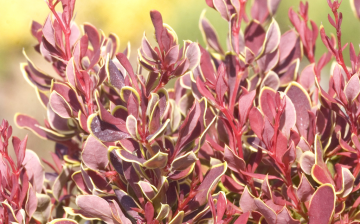
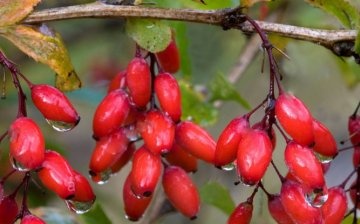
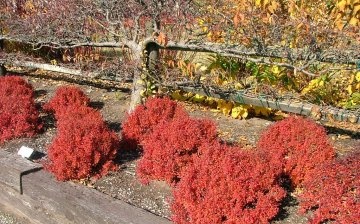
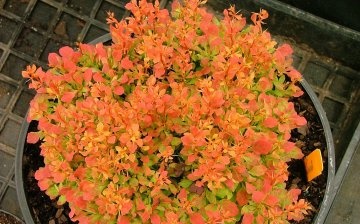
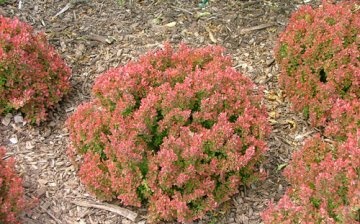
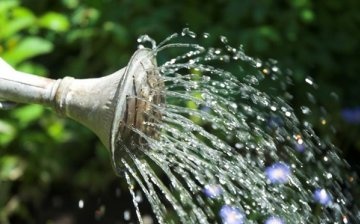
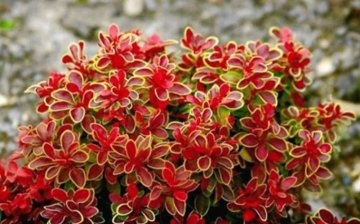
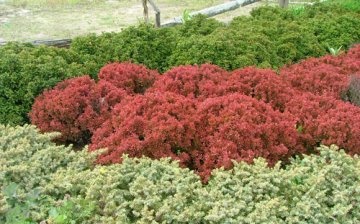








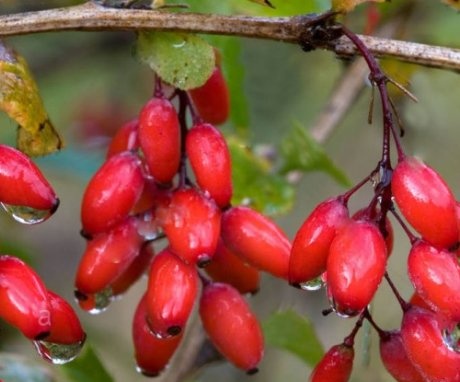
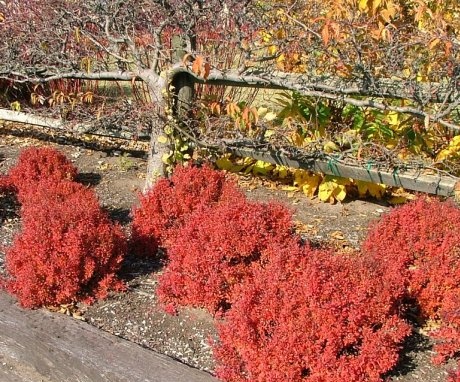
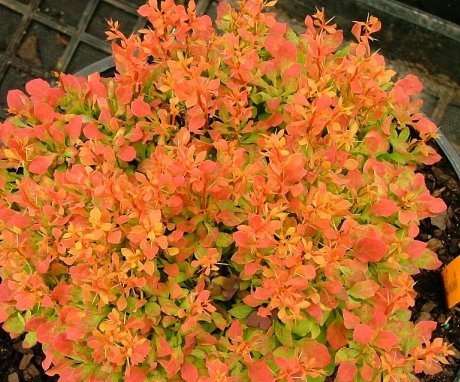
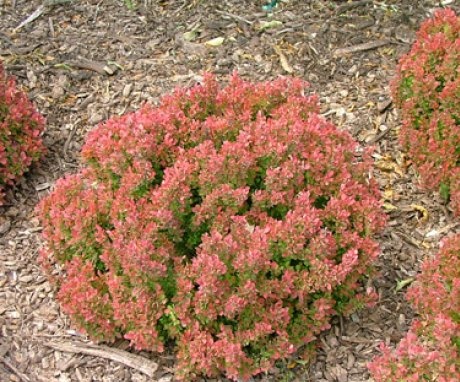
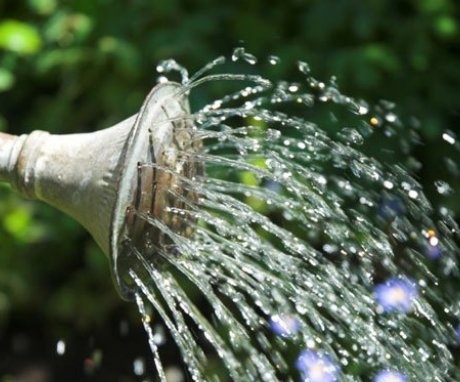
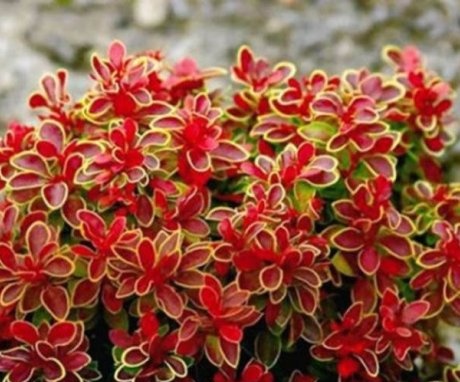
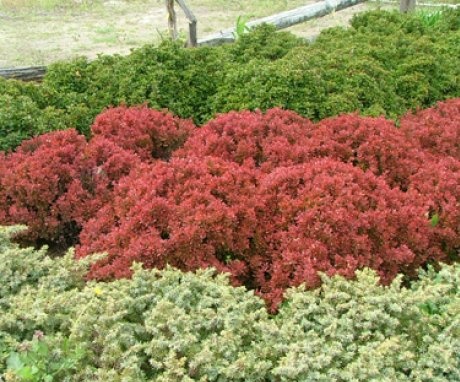
Golden Ruby barberry bushes are very beautiful, so these plants are used to decorate lawns near cafes, restaurants and shopping centers.The leaves are red, "burn" brightly, even at night. Nobody picks or eats barberry fruits, they think that they are inedible.
A very beautiful bush, but in my climatic zone it grows extremely reluctantly, obviously I picked the wrong variety. I will experiment with other varieties, as it looks very nice in landscape design.